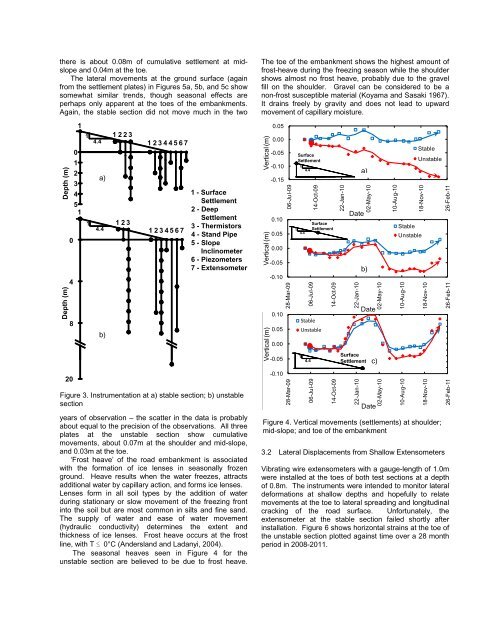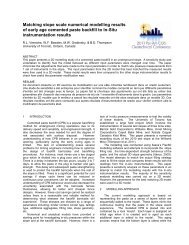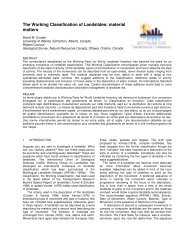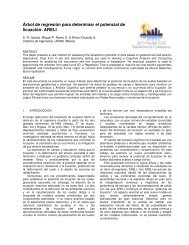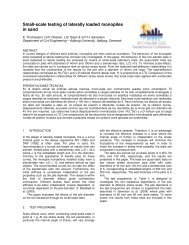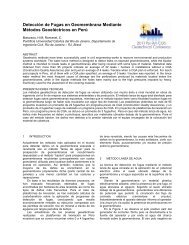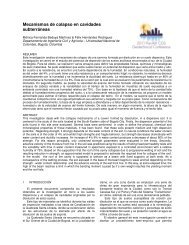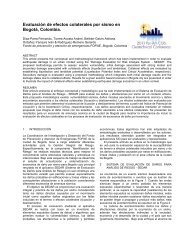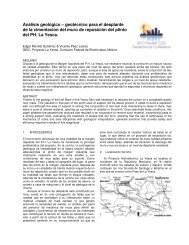Deformations of a highway embankment on degraded permafrost
Deformations of a highway embankment on degraded permafrost
Deformations of a highway embankment on degraded permafrost
Create successful ePaper yourself
Turn your PDF publications into a flip-book with our unique Google optimized e-Paper software.
28-Mar-0906-Jul-0914-Oct-0922-Jan-1002-May-1010-Aug-1018-Nov-1026-Feb-11Vertical (m)Depth (m)28-Mar-0906-Jul-0914-Oct-0922-Jan-1002-May-1010-Aug-1018-Nov-1026-Feb-11Vertical (m)Depth (m)06-Jul-0914-Oct-0922-Jan-1002-May-1010-Aug-1018-Nov-1026-Feb-11Vertical (m)there is about 0.08m <str<strong>on</strong>g>of</str<strong>on</strong>g> cumulative settlement at midslopeand 0.04m at the toe.The lateral movements at the ground surface (againfrom the settlement plates) in Figures 5a, 5b, and 5c showsomewhat similar trends, though seas<strong>on</strong>al effects areperhaps <strong>on</strong>ly apparent at the toes <str<strong>on</strong>g>of</str<strong>on</strong>g> the <str<strong>on</strong>g>embankment</str<strong>on</strong>g>s.Again, the stable secti<strong>on</strong> did not move much in the two040123415114.414.41 2 2 31 2 31 2 3 4 4 5 6 7a) -0.151 2 3 4 5 6 71 - SurfaceSettlement2 - DeepSettlement3 - Thermistors4 - Stand Pipe5 - SlopeInclinometer6 - Piezometers7 - ExtensometerThe toe <str<strong>on</strong>g>of</str<strong>on</strong>g> the <str<strong>on</strong>g>embankment</str<strong>on</strong>g> shows the highest amount <str<strong>on</strong>g>of</str<strong>on</strong>g>frost-heave during the freezing seas<strong>on</strong> while the shouldershows almost no frost heave, probably due to the gravelfill <strong>on</strong> the shoulder. Gravel can be c<strong>on</strong>sidered to be an<strong>on</strong>-frost susceptible material (Koyama and Sasaki 1967).It drains freely by gravity and does not lead to upwardmovement <str<strong>on</strong>g>of</str<strong>on</strong>g> capillary moisture.Elevati<strong>on</strong>0.050.00-0.05-0.100.100.050.00-0.05-0.10SurfaceSettlement14.414.4SurfaceSettlementa)Date Elevati<strong>on</strong>b)StableUnstableStableUnstable8b)0.100.050.00StableUnstableElevati<strong>on</strong> Date-0.0514.4SurfaceSettlementc)20-0.10Figure 3. Instrumentati<strong>on</strong> at a) stable secti<strong>on</strong>; b) unstablesecti<strong>on</strong>years <str<strong>on</strong>g>of</str<strong>on</strong>g> observati<strong>on</strong> – the scatter in the data is probablyabout equal to the precisi<strong>on</strong> <str<strong>on</strong>g>of</str<strong>on</strong>g> the observati<strong>on</strong>s. All threeplates at the unstable secti<strong>on</strong> show cumulativemovements, about 0.07m at the shoulder and mid-slope,and 0.03m at the toe.‘Frost heave’ <str<strong>on</strong>g>of</str<strong>on</strong>g> the road <str<strong>on</strong>g>embankment</str<strong>on</strong>g> is associatedwith the formati<strong>on</strong> <str<strong>on</strong>g>of</str<strong>on</strong>g> ice lenses in seas<strong>on</strong>ally frozenground. Heave results when the water freezes, attractsadditi<strong>on</strong>al water by capillary acti<strong>on</strong>, and forms ice lenses.Lenses form in all soil types by the additi<strong>on</strong> <str<strong>on</strong>g>of</str<strong>on</strong>g> waterduring stati<strong>on</strong>ary or slow movement <str<strong>on</strong>g>of</str<strong>on</strong>g> the freezing fr<strong>on</strong>tinto the soil but are most comm<strong>on</strong> in silts and fine sand.The supply <str<strong>on</strong>g>of</str<strong>on</strong>g> water and ease <str<strong>on</strong>g>of</str<strong>on</strong>g> water movement(hydraulic c<strong>on</strong>ductivity) determines the extent andthickness <str<strong>on</strong>g>of</str<strong>on</strong>g> ice lenses. Frost heave occurs at the frostline, with T ≤ 0°C (Andersland and Ladanyi, 2004).The seas<strong>on</strong>al heaves seen in Figure 4 for theunstable secti<strong>on</strong> are believed to be due to frost heave.DateFigure 4. Vertical movements (settlements) at shoulder;mid-slope; and toe <str<strong>on</strong>g>of</str<strong>on</strong>g> the <str<strong>on</strong>g>embankment</str<strong>on</strong>g>3.2 Lateral Displacements from Shallow ExtensometersVibrating wire extensometers with a gauge-length <str<strong>on</strong>g>of</str<strong>on</strong>g> 1.0mwere installed at the toes <str<strong>on</strong>g>of</str<strong>on</strong>g> both test secti<strong>on</strong>s at a depth<str<strong>on</strong>g>of</str<strong>on</strong>g> 0.8m. The instruments were intended to m<strong>on</strong>itor lateraldeformati<strong>on</strong>s at shallow depths and hopefully to relatemovements at the toe to lateral spreading and l<strong>on</strong>gitudinalcracking <str<strong>on</strong>g>of</str<strong>on</strong>g> the road surface. Unfortunately, theextensometer at the stable secti<strong>on</strong> failed shortly afterinstallati<strong>on</strong>. Figure 6 shows horiz<strong>on</strong>tal strains at the toe <str<strong>on</strong>g>of</str<strong>on</strong>g>the unstable secti<strong>on</strong> plotted against time over a 28 m<strong>on</strong>thperiod in 2008-2011.


